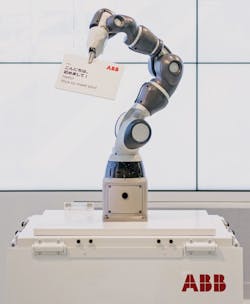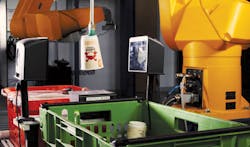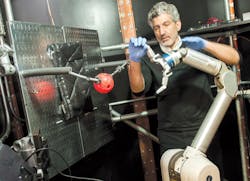Robots pick groceries, make sushi, assist amputees
Artificial intelligence and robots in the news lately range from Jibo the social robot to algorithms that can take on management tasks. Of course, Jibo can move his head, but he can’t make sushi.1 Management algorithms can’t directly manipulate objects, either; they can only give orders for employees to carry out.2
Several new and newsworthy robots can directly manipulate real-world objects, however. They include a new member of the YuMi family from ABB, a grocery-picking robot from Ocado Technology, and a robotic arm developed at the University of Chicago that shows promise for assisting amputees.
From factory to market
ABB describes its YuMi family of collaborative robots as being designed to work alongside humans on the factory floor to boost productivity and support the transition to mass customization. The company previewed its new single-arm version, vs. two arms for earlier models, at the International Robotics Exhibition (iREX) 2017 in Tokyo Nov. 29 through Dec. 2.
“The success of YuMi has exceeded expectations; it was originally designed for small-parts assembly, but it has turned out to be exceptionally versatile—it can solve a Rubik’s Cube, make sushi, wrap gifts, and conduct an orchestra,” said Sami Atiya, president of ABB’s Robotics and Motion division, in a press release.
In addition, Ocado Technology, a division of Ocado, the British online-only supermarket, touted a new robotic system capable of picking a range of grocery products from the 50,000 different items available on Ocado.com. A proprietary computer-vision system designed by the Ocado Technology robotics research team calculates grasping points for a given item without requiring a 3D model of the object to be picked.
The robotic system uses a vacuum cup as the gripping device attached to the end of an articulated arm. When connected to an air compressor, the arm can lift items regardless of their deformability and shape, as long as they are within the weight restriction, and the suction cup can create an airtight seal with the item’s surface.
Amputees and robotic arms
Finally, neuroscientists at the University of Chicago have demonstrated that amputees can learn to control a robotic arm through electrodes implanted in their brains. The research shows that both the brain and the remaining intact limb create new connections to control the robotic arm, even several years after an amputation.
“That’s the novel aspect to this study, seeing that chronic, long-term amputees can learn to control a robotic limb,” said Nicho Hatsopoulos, Ph.D., professor of organismal biology and anatomy at the University of Chicago and senior author of a paper describing the research. “But what was also interesting was the brain’s plasticity over long-term exposure, and seeing what happened to the connectivity of the network as they learned to control the device.”3
The researchers worked with three Rhesus monkeys who suffered injuries at a young age and had to have an arm amputated to rescue them four, nine and 10 years ago, respectively. Their limbs were not amputated for the purposes of the study. Previous experiments have shown how paralyzed human patients can move robotic limbs through a brain-machine interface, but the researchers say the new study is one of the first to test the viability of these devices in amputees as well.
“We have successfully demonstrated that learning to use a cortically-controlled BMI to perform a complex, sequential task is possible in chronically amputated animals,” the researchers write in their paper.4 “This is significant as it is known that the motor cortex undergoes reorganization following amputation and thus has clinical implications for human amputees.”
References
- Nelson, Rick, “Jibo prompts concerns about ‘the illusion of companionship’,” Rick’s Blog, EE-Evaluation Engineering Online, Dec. 11, 2017.
- Nelson, Rick, “AI is coming for the managers,” Rick’s Blog, EE-Evaluation Engineering Online, Dec. 11, 2017.
- “Amputees Can Learn to Control a Robotic Arm with Their Minds,” Newswise, Nov. 27, 2017.
- Balasubramanian, Karthikeyan, et al., “Changes in cortical network connectivity with long-term brain-machine interface exposure after chronic amputation,” Nature Communications, Nov. 27, 2017.
About the Author

Rick Nelson
Contributing Editor
Rick is currently Contributing Technical Editor. He was Executive Editor for EE in 2011-2018. Previously he served on several publications, including EDN and Vision Systems Design, and has received awards for signed editorials from the American Society of Business Publication Editors. He began as a design engineer at General Electric and Litton Industries and earned a BSEE degree from Penn State.



